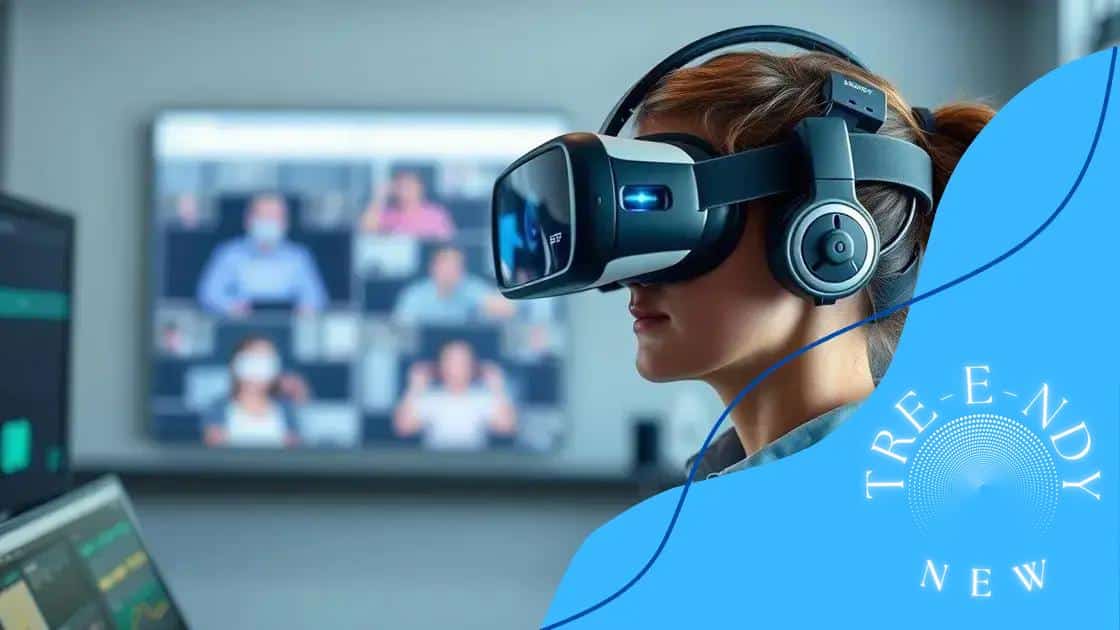Virtual reality for immersive training: elevate your skills

Virtual reality for immersive training provides engaging, realistic simulations that enhance skill acquisition across various industries, including healthcare, education, and manufacturing.
Virtual reality for immersive training is changing how we learn and develop skills. Imagine stepping into a realistic environment where you can practice without limits. Curious about how this technology could transform your own learning journey? Let’s dive in!
Understanding virtual reality technology
Understanding virtual reality technology is essential for grasping its impact on training and development. By immersing users in simulated environments, VR creates unique experiences that enhance learning.
What is virtual reality?
Virtual reality involves using technology to simulate a real-world environment. Users typically wear headsets that transport them to different settings, allowing for interactive experiences. It’s not just about gaming; industries are leveraging VR for training purposes, educational simulations, and skill development.
Key components of VR technology
The main components that make up virtual reality technology include:
- VR Headsets: These devices are worn on the head, blocking out the physical world and displaying a virtual scene.
- Motion Tracking: Sensors track the user’s movements, allowing their actions to affect the virtual environment.
- Controllers: Handheld devices that let users interact with the virtual world, like grabbing objects or navigating.
As users explore these virtual spaces, they can engage with interactive elements that reinforce learning. For instance, medical students can practice surgeries in a safe environment without real-life consequences. This hands-on method proves beneficial, helping learners retain knowledge and skills.
Applications of VR in various fields
Virtual reality technology is revolutionizing numerous sectors, from healthcare to aviation. Here are a few areas where VR is making a difference:
- Healthcare: Training doctors through simulated surgical procedures allows for greater experience without risk.
- Education: Students can explore historical sites or scientific phenomena virtually, enhancing engagement.
- Corporate Training: Companies use VR for employee onboarding, offering real-life scenarios to enhance understanding.
As VR continues to evolve, it offers immense potential for creating more effective training tools. When incorporated into learning programs, it provides an interactive approach that is often more efficient than traditional methods.
Benefits of immersive training methods
The benefits of immersive training methods are vast and transformative. By engaging learners in realistic environments, these methods create deeper understanding and retention of skills.
Enhanced Engagement
Immersive training methods hold the attention of participants more effectively than traditional methods. Learners are more motivated to engage with content when it feels real and relevant. This engagement improves their focus and allows for better knowledge retention.
Realistic Simulations
One of the key advantages of immersive training is the realistic simulations that allow learners to practice skills in a safe environment. This is especially valuable in fields such as medicine and aviation, where training on real equipment or situations can be risky. Users can encounter and solve problems they may face in real-life scenarios without the consequences of actual failure.
- Hands-on Experience: Participants can physically interact with situations, which enhances practical understanding.
- Immediate Feedback: Instant feedback during training helps learners adjust and improve quickly.
- Stress Management: Participants can experience high-pressure scenarios in a safe space, preparing them for real challenges.
Furthermore, immersive training methods cater to various learning styles. Some learners may benefit from visual experiences, while others thrive on kinesthetic learning. This diversity allows for a more inclusive approach to education and skill development.
Cost Efficiency
Although there may be an initial investment in immersive training technology, the long-term benefits often outweigh these costs. Organizations save money on resources, travel, and training time. In addition, the ability to reuse virtual training modules can significantly cut ongoing training expenses.
Ultimately, the advantages of immersive training methods are clear. By harnessing technology to create engaging, practical experiences, these methods prepare learners effectively for their future roles, ensuring they are equipped with the necessary skills and knowledge.
How industries are using virtual reality

Many industries are discovering how to use virtual reality effectively for various applications. This technology transforms the way companies operate, train employees, and engage customers.
Healthcare Applications
In the healthcare sector, virtual reality is a game-changer. Medical professionals utilize VR for training and surgical simulations. Students can perform virtual surgeries, gaining experience without putting patients at risk. This practice enhances their skills and confidence.
Education and Training
Education is another area benefiting from virtual reality. Schools and universities are incorporating VR to create engaging learning environments. Students can explore historical sites, biological systems, or even outer space from their classrooms. This interactive experience motivates learners and helps them understand complex concepts.
- Field Trips: Virtual field trips allow students to visit places they might never see in person.
- Hands-On Learning: VR provides practical applications for theories learned in class.
- Enhanced Collaboration: Students can work together in virtual spaces, breaking geographical barriers.
Many businesses have adopted virtual reality for training purposes as well. Companies use immersive simulations to prepare employees for high-stakes situations. Sectors like aviation and manufacturing benefit from this as workers can practice in a risk-free space. Simulating real-life challenges helps them develop problem-solving skills while reducing training costs.
Marketing and Customer Engagement
Furthermore, industries are leveraging virtual reality for marketing initiatives. Companies can create immersive experiences that allow potential clients to interact with products. For example, auto manufacturers offer virtual test drives, giving customers the chance to explore features without visiting a dealership. This innovative approach not only attracts attention but also builds a stronger connection with the audience.
As more industries realize the potential of virtual reality, its use will likely expand. This technology championing immersive experiences can greatly enhance learning and customer engagement.
Creating effective VR training programs
Creating effective VR training programs requires careful planning and understanding of learner needs. Implementing immersive technology can bring significant benefits, but it must be done thoughtfully.
Identify Learning Objectives
The first step in developing a VR training program is identifying clear learning objectives. What skills or knowledge do you want participants to gain? Having specific goals helps guide the design of the content and simulations. It also allows for assessing whether the training is successful.
Curriculum Design and Structure
A well-structured curriculum is vital for an effective VR training program. The program should balance theoretical knowledge with practical application. Start with fundamental concepts and gradually increase complexity. Including various scenarios keeps learners engaged.
- Interactive Elements: Incorporate interactive components that encourage exploration and problem-solving.
- Realistic Simulations: Develop high-quality simulations that replicate real-world situations.
- Feedback Mechanisms: Ensure immediate feedback is available so learners can improve and correct mistakes on the spot.
Another important aspect is ensuring that the VR experience is accessible. Users should feel comfortable and at ease using the technology. Providing clear instructions and support helps to reduce anxiety and enhances the learning experience. Training programs should also be designed to accommodate different skill levels and learning preferences.
Testing and Evaluation
Regular testing and evaluation of the VR training program is essential for continuous improvement. Gathering feedback from participants helps identify areas for enhancement. Surveys and performance metrics can provide insights into how effectively the training meets its objectives.
Once you have implemented the program, it’s important to stay updated with advancements in VR technology. As new tools and techniques emerge, incorporating them can enhance the quality of training experiences. Regularly updating the content keeps the program current and relevant, ensuring the training remains effective.
The future of training with virtual reality
The future of training with virtual reality holds exciting possibilities. As technology evolves, so does the potential for immersive learning experiences. This innovation is reshaping how skills are taught and developed in various fields.
Advancements in VR Technology
New advancements in virtual reality hardware and software are making it more accessible and user-friendly. As headsets become lighter and more affordable, more institutions are likely to adopt this powerful tool for training. Improved graphics and interactivity enhance the realism of simulations, leading to better learning outcomes.
Personalized Learning Experiences
One significant shift in the future of training is the move towards personalized learning experiences. With VR, programs can adapt to individual learner needs. This means that students can work at their own pace and focus on areas where they need the most practice.
- Adaptive Learning: VR can track progress and provide tailored learning paths based on student performance.
- Skill Assessment: Immediate feedback helps learners understand their strengths and weaknesses quickly.
- Scenario Variability: Different scenarios can be created to match individual experiences, making learning more relevant.
Additionally, the integration of artificial intelligence is set to enhance virtual training programs significantly. AI can analyze user data to create realistic challenges and adjust difficulty levels in real-time. This creates a dynamic training environment that evolves with the learner.
Integration with Remote Learning
The future will likely see more integration between virtual reality training and remote learning platforms. This combination allows learners from different locations to participate in the same immersive experiences. Virtual classrooms can simulate real-world environments, fostering collaboration among students regardless of their physical location.
Overall, the future of training with virtual reality is bright and full of potential. As technology advances, we can expect to see even more innovative applications that enhance learning, engagement, and skill development.
virtual reality is transforming training across all industries. It offers immersive and engaging experiences that help learners acquire skills effectively. As technology continues to evolve, the possibilities for VR training will expand, providing personalized and dynamic learning opportunities. Embracing these advancements can lead to better preparedness and higher competency levels for individuals in their respective fields.
FAQ – Frequently Asked Questions about Virtual Reality Training
What are the main benefits of using virtual reality in training?
Virtual reality enhances engagement, provides realistic simulations, and allows for personalized learning experiences, making training more effective.
How does virtual reality cater to different learning styles?
VR adapts to various learning styles by offering interactive experiences, visual aids, and hands-on practice, ensuring inclusivity for all learners.
What industries are currently using virtual reality for training?
Industries such as healthcare, aviation, education, and manufacturing are leveraging virtual reality to provide immersive training to their employees.
What does the future hold for virtual reality training programs?
The future of VR training includes advancements in technology, increased personalization, and greater integration with remote learning platforms, enhancing the learning experience.





